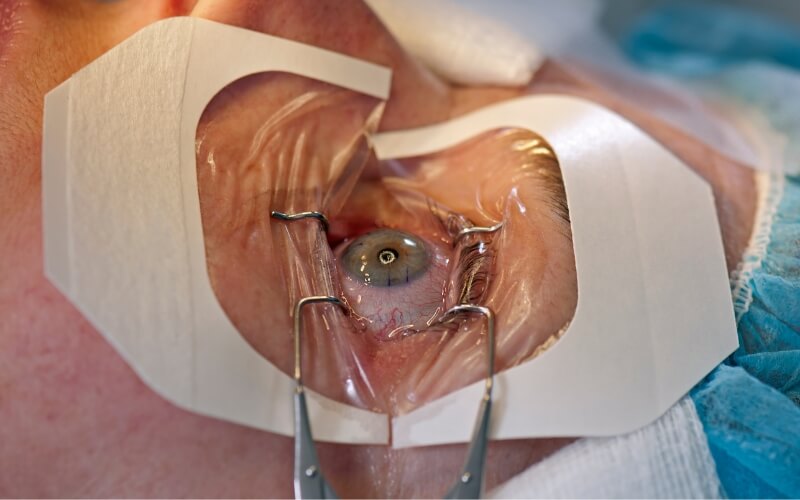While retinal detachment is fairly uncommon, doctors are worried about an increasing number of patients with high myopia showing symptoms of retinal detachment, which, if ignored, could lead to blindness. To the uninitiated, retinal detachment refers to a condition where the retina pulls away from its normal position, i.e., the retinal cells separate from the layer of blood vessels providing oxygen and nourishment to the eye. Treatment includes retinal detachment surgery to fix the tears and reattach the retina to the back of the eye. Read on to learn more about retinal detachment, including procedure, cost of the surgery, side effects, and recovery time.
Retinal Detachment Surgery
Treatment varies depending on how much the retina is detached and the type of detachment. Depending on the diagnosis, the doctor may suggest laser surgery, vitrectomy, or pneumatic retinopexy. Common retinal detachment surgery types include:
Laser Surgery Or Cryopexy
If the tear or hole is small, the ophthalmologist may fix it through laser surgery or freeze treatment, called cryopexy. The choice between these two options depends on the location of the tear. Laser surgery involves shining a laser inside the eyes to make a small burn around the tear or hole. These burns then create scars that fix the tear and hold the retina in place. Freeze treatment or cryopexy involves using a tool called a freezing probe over the tear – the cold from this probe creates a scar around the tear, thereby keeping the retina in place. Both of the above retina detachment surgery procedures involve putting a numbing medicine in the eye before proceeding to repair the tear or hole. The doctor may prescribe special eye drops to prevent the eyes from swelling and advise against vigorous exercises until the eyes heal.

Pneumatic Retinopexy
Pneumatic retinopexy involves repairing the detached retina by pushing it in place using a gas bubble. The patient is positioned such that the bubble floats over the detached area, thereby pushing it against the back of the eye. The doctor then seals the retina using a freezing device. As with other retina detachment surgery procedures, the doctor may start by giving eye drops to dilate the eyes and numb the area. They may also remove any fluid from inside the eye before injecting the bubble. The doctor will offer clear instructions about positioning the head after the procedure to reduce complications. This includes keeping the head in a certain position for up to 8 hours after pneumatic retinopexy. As part of the retinal detachment surgery recovery instructions, the doctor may advise against flying for some time and avoiding strenuous activities.
Vitrectomy
Vitrectomy is a retinal detachment surgery that helps repair the detached retina by removing the vitreous and other tissue on the retina. Blood, scar tissues, or any other substance preventing the light from focusing on the retina is also removed. The vitreous is replaced with a saltwater solution or a bubble of silicone oil, or gas. Post-surgery, as the eyes heal, the saline solution is slowly replaced with aqueous humor, the natural fluid in the eye. If silicone oil was used, the patient may need another procedure after several months to remove the substance. As for processes involving gas bubbles, patients must strictly avoid air travel to reduce the risk of elevated eye pressure. The retinal detachment surgery procedure is done as an outpatient process by making a small cut or using special blades to enter the eyes. As for retinal detachment surgery recovery, the ophthalmologist may prescribe medicines to heal the eyes and relieve any discomfort.
Scleral Buckling
This retinal detachment surgery involves suturing silicone material to the sclera to indent the wall and relieve some of the force caused by the tear or hole in the retina. The procedure is done only in cases of extensive detachment, wherein a scleral buckle is created to encircle the eyes like a belt. As with all retinal detachment surgeries, scleral buckling also comes with its share of risks, including eye infection, bleeding in the eye, and increased risk for glaucoma. Recovery takes time and includes wearing an eye patch for a few weeks after surgery and taking pain medication until the doctor prescribes.
How to Find Reputable Eye Hospitals in Nagercoil?
When looking for reputable eye hospitals in Nagercoil, we suggest you seek references from friends and family. Check the overall experience of the hospital and the eye specialist offering to perform the procedure. Visit us if you are looking for an experienced eye specialist in Nagercoil offering retinal detachment surgery at an affordable price.
